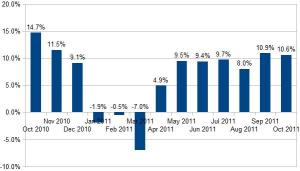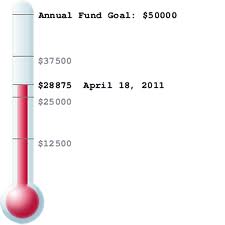 This week I’m looking back upon 2011 for major trends, and then looking forward to 2012 with an eye towards making a few predictions. Today, we are looking at non-profit online giving and ePhilanthropy.
This week I’m looking back upon 2011 for major trends, and then looking forward to 2012 with an eye towards making a few predictions. Today, we are looking at non-profit online giving and ePhilanthropy.
Back in late July and early August, I focused my blog posts on the various faces of ePhilanthropy including: Twitter, Facebook, online videos, website, and email. Ever since writing those post, I’ve kept my eyes open for evidence of this trend, and I must admit that I see indicators everywhere pointing to:
2012 will continue the long-term transition towards online giving.
Every year at this time, I read blogs predicting that the upcoming year will be “The Year of ePhilanthropy,” and every year I look back and fail to see the big transformation. Well, I am being a big ‘ol dummy because the transformation isn’t going to be dramatic and sudden. The change (as is the case with most trends) will take place over time, and in fact it has been taking place for years.
The proof can be found in the data and analytics provided by Blackbaud who publishes a monthly index of online giving that compares year-over-year online giving statistics. Take a look at the last 12-months and let me know if you see can see the proof in the pudding:
While the overall gross revenue from online giving is still relatively small (between $5 and $10 billion), the trend arrow is pointing up-up-up and has been for many years. Additionally, this trend is not just being fueled by large, multinational health and disaster relief organizations. I was surprised when I saw how much year-over-year growth in online giving came from small non-profit agencies and organizations in the non-profit human services sector. If you have some time, I encourage you to click here and dive into Blackbaud’s treasure trove of data.
 Of course, what gives me the most confidence in predicting this trend is what I see going on with our “for-profit cousins” and e-commerce. Click here to check out some very cool e-commerce infographic at “Next Widgets” blog. If my eyes aren’t deceiving me, I see parallels between e-commerce and ePhilanthropy.
Of course, what gives me the most confidence in predicting this trend is what I see going on with our “for-profit cousins” and e-commerce. Click here to check out some very cool e-commerce infographic at “Next Widgets” blog. If my eyes aren’t deceiving me, I see parallels between e-commerce and ePhilanthropy.
More and more people are spending time and money online, and this reality can mean only one thing for non-profit organizations. As a matter of fact, this trend isn’t just confined to non-profit and for-profit businesses. Just last night Rock Center with Brian Williams featured a news segment on individuals who are using crowdfunding sources like Kickstarter to secure financial resources for things ranging from start-up projects to catastrophic healthcare expenses. Click here to read and see more.
Unfortunately, this trend is not as simple as it seems. The online world is constantly changing . . . what seemed as easy as building a website with a “donate now” button is now more complicated with Facebook, Twitter, LinkedIn, Google+, YouTube, WordPress, and email marketing (e.g. Constant Contact). All of these things work together like little cogs in a complicated machine.
More distressing is how quickly the landscape changes. I can still remember when AOL was the future of all cyber-things (and it wasn’t just me who thought this to be true . . . go talk to our friends over at Time Warner . . . LOL), and today it is all about Google and Facebook. Well, just wait because in no time we might just find ourselves saying the same thing about these new digital overlords as we ohhhh and ahhhh over the next greatest thing.
 It sounds like 2012 will be the year that Facebook finally takes itself public with an IPO designed to raise $10+ billion dollars. I suspect that 2012 will be the “Year of Facebook,” and non-profit organizations who haven’t figured out how to use Facebook to talk AND listen to their supporters, donors, and volunteers will be starting on that project very soon. Click here to read a few interesting statistics about online giving via social media vehicles.
It sounds like 2012 will be the year that Facebook finally takes itself public with an IPO designed to raise $10+ billion dollars. I suspect that 2012 will be the “Year of Facebook,” and non-profit organizations who haven’t figured out how to use Facebook to talk AND listen to their supporters, donors, and volunteers will be starting on that project very soon. Click here to read a few interesting statistics about online giving via social media vehicles.
You might want to re-think your online giving plan if your strategy is “wait-and-see”. If you want to “get the lay of the than land,” I suggest circling back and reading my posts from July 25 – August 2 about ePhilanthropy (see links at top of this post). I ended that blog series with a post titled “ePhilanthropy: Mission Possible” that provided a few small steps for getting started.
Let me end with these cautionary words: online giving and the internet will NOT overtake traditional fundraising strategies and tactics such as face-to-face solicitation, direct mail, special events, grantwriting, etc. ePhilanthropy and all of its tactics are just more tools that you need to add to your resource development toolbox if you want your non-profit agency to thrive in the 21st Century.
So, please don’t run out there and invest tons of money and hours in ePhilanthropy in 2012 and expect that you’ve solved all of your revenue issues. However, please stop procrastinating and get to work on engaging your existing and future donors online.
This trend is starting to look like an out-of-control freight train, and you want to make sure you are on board and not standing in its way.
Does your agency have a written ePhilanthropy plan? If so, what does it look like? If not, what are your plans for tackling this emerging trend?
Here’s to your health!
Erik Anderson
Founder & President, The Healthy Non-Profit LLC
www.thehealthynonprofit.com
erik@thehealthynonprofit.com
http://twitter.com/#!/eanderson847
http://www.facebook.com/eanderson847
http://www.linkedin.com/in/erikanderson847



















